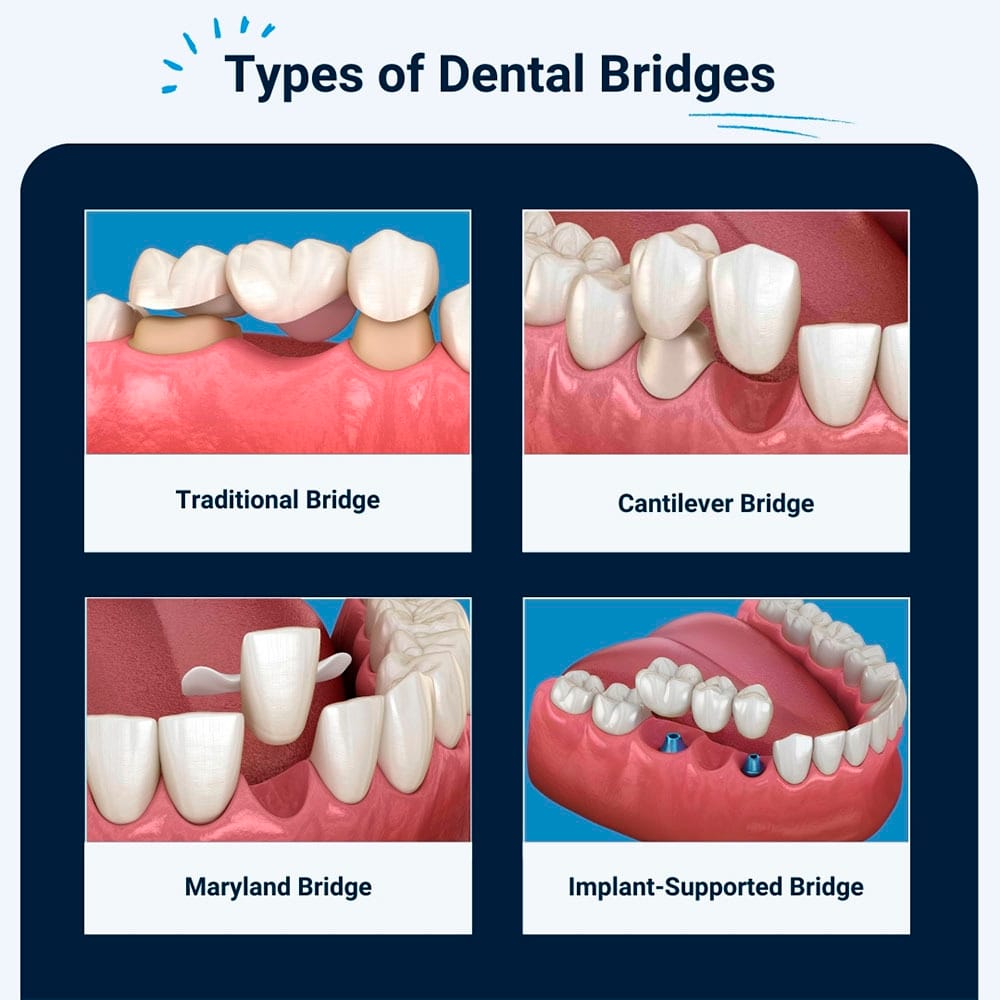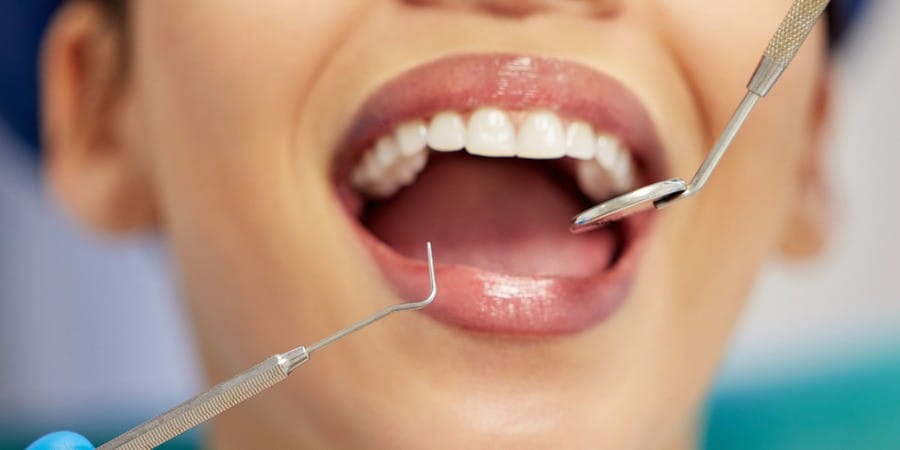This article explains more about dental bridges, how they work, and the procedure required to make and fit them. We discuss the pros and cons of having a dental bridge and how to help them last longer.
What Is a Dental Bridge?
A dental bridge is designed to replace one or more teeth originally in a row. It consists of crowns that will fit over natural teeth adjacent to the gap. The teeth that are used for support are called abutment teeth. Normally, one tooth on either side of the gap is used for support.
The crowns support a pontic between them. A pontic is an artificial tooth that will rest on the gum underneath. Two crowns that can support one or more pontics that are side by side.
Several types of dental bridges exist, and they are outlined below.

Read more: Metal Crowns vs. Porcelain Dental Crowns
Traditional Bridge
A traditional dental bridge is the most common type of bridge. It has crowns bonded onto teeth on either side of the gap and supporting the artificial teeth or pontics between them. The result is a strong and stable dental restoration.
Cantilever Dental Bridge
Not everyone has natural teeth suitable for crowns on both sides of the gap, or the teeth on one side may be too weak to support a bridge. In this case, the dentist may suggest a cantilever bridge.
Unlike a traditional bridge supported on both sides, the bridge is cantilevered off just one side; the pontic is unsupported on the other side.
Because of their design, a cantilever bridge isn’t as strong as a traditional bridge. Therefore, it tends to be used when the biting and chewing load is less, such as when replacing front teeth.
Maryland Bridge
A Maryland bridge is sometimes called a resin-bonded bridge because it doesn’t use crowns to support it. Instead, the pontic is supported by wings custom-designed to fit on the inner surfaces of the teeth on either side of the gap.
These bridges are typically weaker and are generally used to replace front teeth. They don’t tend to be strong enough to replace back teeth that are subject to greater chewing forces.
When you see your dentist for tooth loss, they can assess your oral health and discuss which type of bridge will suit you best.
Factors that can influence this choice include:
- The number of teeth that are missing.
- If natural teeth are present for possible support of a dental bridge.
- The health of these natural teeth next to the gap.
- Your oral health.
- Your personal preference and budget.
After assessing your mouth, your dentist can provide a treatment plan detailing all possible options and the predicted costs, which can vary according to the materials used and the number of teeth that must be replaced. They can also show you examples of each bridge and available materials that suit your needs and budget.
What to Expect When You Have a Dental Bridge Made and Fitted
It will usually take two or three visits to your dentist to have your bridge made and fitted. The exact procedure will depend on the type of bridge you choose, but a general idea of what to expect is outlined below.
Read more: What are the Stages of Periodontal Disease?
Tooth Preparation
When you have a dental bridge supported by crowns fitted over your natural teeth, these teeth must be prepared. Your dentist will numb these teeth before removing some tooth structure, carefully shaping them so they are ready to be crowned.
Dental crowns need to be a certain thickness, so removing this tooth structure ensures they look and feel as natural and comfortable as possible.
If you have a Maryland bridge, tooth preparation is unnecessary, as the tooth surfaces simply need to be etched before the bridge is fitted.
Dental Impressions
Once your teeth are prepared, your dentist will take a dental impression. Some dentists do this using a traditional tray impression. Others have a digital scanner that will scan your teeth instead.
Making Your New Bridge
The impression or scan is sent to the dental lab with your dentist’s prescription. The prescription will include the type of bridge required, the design, and the shade of porcelain to be used.
It can take up to 2 weeks or more for a bridge to be made. In the meantime, your dentist may need a temporary restoration to protect prepared teeth and fill in the gap.
Read more: Preparing for Gum Graft Surgery: A Step-by-Step Guide
Fitting Your New Bridge
When your bridge is ready you return to the dental office so it can be fitted in your mouth. Your dentist will check that it fits precisely and securely and looks good before permanently cementing it in place.
What are the Pros and Cons of Having a Dental Bridge?
Dental bridges are a reliable and reasonably long-lasting way to replace missing teeth, but any treatment has pros and cons.
The advantages of choosing a dental bridge can include:
- A natural-looking solution for missing teeth.
- A dental bridge prevents neighboring teeth from shifting out of place.
- The bridge helps spread the load created when you bite and chew food.
- Treatment is minimally invasive and fairly quick to complete.
Disadvantages of choosing a dental bridge can include:
- The additional strain of biting and chewing can stress the abutment teeth used for support.
- Over time, there is an increased risk that these abutment teeth could fracture or fail.
- Preparing abutment teeth can increase the risk that they will become infected and decay in the future, especially as the crowns begin to age and leak.
- Removing healthy tooth structure from abutment teeth is less than ideal, as this tooth structure can only be replaced artificially and will not grow back.
Read more: Tips for Eating with New Dentures
Are There Any Alternatives to Having a Dental Bridge?
Natural teeth support all of the above bridges, but they aren’t always present. In this case, an implant-supported bridge can provide an alternative. Instead of natural teeth for support, dental implants are used.
Dental implants are a more modern way to restore missing teeth and are long-lasting. Implants are self-supporting and help preserve and protect the jawbone around them. Jawbone loss naturally occurs after tooth roots are removed, and dental implants are the only tooth loss solution that can provide this protective effect.
However, dental implants are more expensive, and oral surgery is needed to fit them. Not everyone will want or is suitable for this treatment.

